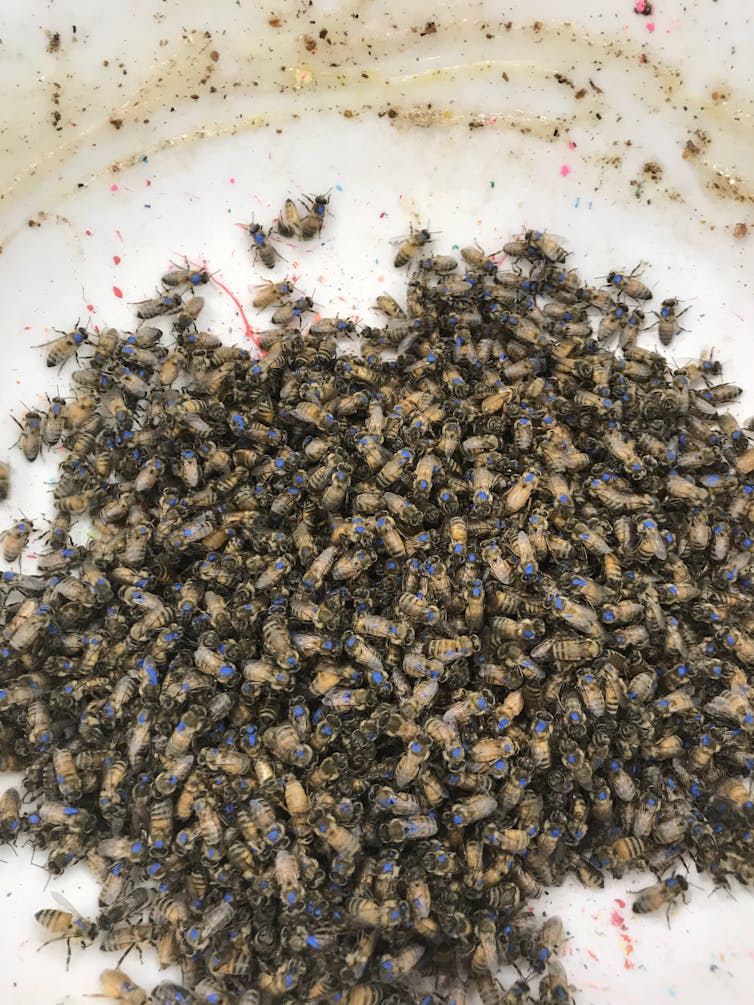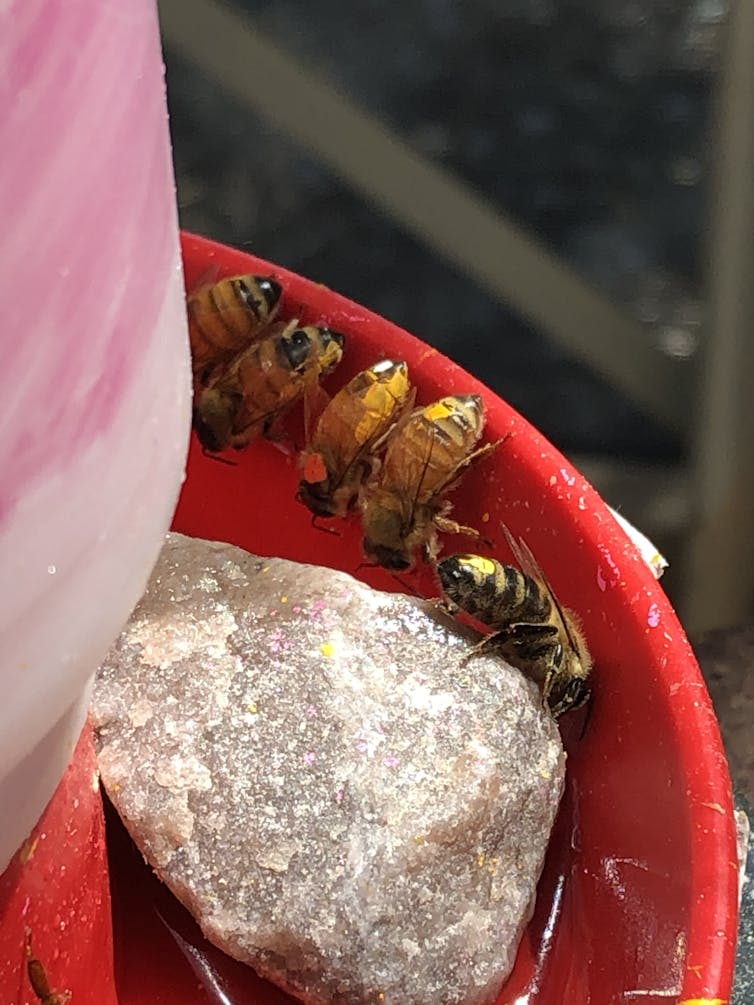Some bees are born curious while others are more single-minded – new research hints at how the hive picks which flowers to feast on
- Written by Chelsea Cook, Assistant Professor in Biology, Marquette University
When you try to pick a restaurant with a group of friends, how do you decide? Your curious friend wants to try the new place, while your focused friend wants to go to the old faithful. One friend is insistent, while the other is more quiet. Ultimately, the focused vocal friend convinces the group by saying, “I am telling you, this is the best place. It’s a sure thing – we gotta go!”
Just like people, honey bees vary in how they seek out food and communicate where to go. As a biologist, I study collective behavior[1], especially how groups make decisions. My colleagues and I have discovered[2] some individual bees are seemingly born with a predetermined foraging style – they can be either focused foragers or curious foragers. Having different approaches to collecting food turns out to be advantageous for large colonies that rely on a changing food landscape.
Explorers and exploiters
As animals collect food, they must balance exploring for new food with exploiting already known food sources. Individual animals have to do one or the other, switching between exploring or exploiting. In collectives, like honey bee colonies, foragers can split the work and do both at the same time.
As honey bees forage for nectar and pollen, they learn a lot of information about the flowers they visit, such as their smells[3], colors[4] and locations[5]. Some bees become extremely focused on information associated with food, ignoring any new information – similar to selective attention in humans. Conversely, other bees exhibit a learning behavior marked by curiosity. They are interested in learning about new food sources, not just familiar ones.
True to type
My colleagues and I became interested in how bee colonies manage and act on these two types of information. To answer this question, we first figured out how to breed curious bees and focused bees.
We tested female queens and male drones to see if they were curious or focused, and then used artificial insemination to breed a curious queen with a curious drone, and a focused queen with a focused drone. Typically queens mate with 12 to 15 different drones and create genetically diverse workers, so using a single drone helped keep workers genetically uniform.
 One-day-old curious bees marked blue.
Sebastian Scofield, CC BY-SA[6]
One-day-old curious bees marked blue.
Sebastian Scofield, CC BY-SA[6]
Once we had populations of genetically curious and focused bees, we had to verify they would not be influenced by their social environment. We did this by placing bees in colonies of either their own learning type or one with an assortment of learning types. (We kept track of who was who by marking them with paint on their thorax as soon as they were born.) Sure enough, regardless of the social group the bees experienced, they exhibited the same learning behavior we observed in their parents.
Familiar food versus novel food
Next, we created colonies of all focused bees, all curious bees or a 50/50 mix of focused and curious bees – then watched how they foraged.
We gave them a choice between two food locations: a familiar, reliable food location that stayed in the same spot for four days or a new food location that changed odor, color and location every day. Both locations contained the same quality and quantity of food. We marked bees on their abdomens as they visited the feeders so we knew which ones they had been to and which ones they were revisiting.
 Researchers marked the bees visiting this feeder with yellow.
Chelsea Cook, CC BY-SA[7]
Researchers marked the bees visiting this feeder with yellow.
Chelsea Cook, CC BY-SA[7]
We discovered the focused colony quickly found the familiar food location and exploited that eatery all week, rarely visiting the novel food option.
The curious colony, as expected, visited the novel and the familiar food locations equally, showing no preference.
Interestingly, the 50/50 mixed colony ended up acting more like the focused colony, using the familiar feeder and paying little attention to the novel feeders. We observed the curious bees in the mixed colony shifted their selected behavior by visiting the familiar feeder more than the novel one. Why?
 The bee in the middle communicates the location of food using the waggle dance.
The bee in the middle communicates the location of food using the waggle dance.Dancing up a storm
When honey bees find a good source of food, they use the waggle dance to direct their nest mates[8]. This dance communicates the distance to and direction of a nutritious meal, as well as its perceived quality. When we looked at waggle dance behavior in the 50/50 colony, we saw the focused bees were dancing more intensely – performing 0.59 turns per second, significantly faster than the curious bees’ 0.52 turns per second. Just like your vocal, excited friend, the focused bees attracted more followers, so more bees were recruited to the familiar, reliable feeder.
Because curious bees are interested in everything, including new information about possible food locations, they are perfect listeners and are easily convinced to visit the chosen feeder of their enthusiastic nest mates.
[Deep knowledge, daily. Sign up for The Conversation’s newsletter[9].]
Our future work will investigate how these foraging dynamics work in a changing food landscape – one where food runs out. If a source is depleted, will the focused bees turn their attention to the curious bees, who already know where other foraging locations are?
This research suggests successful societies make better decisions when members, by virtue of their innate learning styles, collect and communicate a diversity of information – whether they are bees looking for nectar or friends trying to decide on a restaurant. Diversity of learning behavior in individuals may help social groups adapt to shifting global environments.
References
- ^ I study collective behavior (scholar.google.com)
- ^ My colleagues and I have discovered (doi.org)
- ^ smells (doi-org.ezproxy1.lib.asu.edu)
- ^ colors (www.jstor.org)
- ^ locations (www.hup.harvard.edu)
- ^ CC BY-SA (creativecommons.org)
- ^ CC BY-SA (creativecommons.org)
- ^ waggle dance to direct their nest mates (www.hup.harvard.edu)
- ^ Sign up for The Conversation’s newsletter (theconversation.com)
Authors: Chelsea Cook, Assistant Professor in Biology, Marquette University

